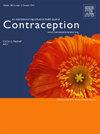ELIGIBILITY FOR MEDICATION ABORTION WITH ASYNCHRONOUS SCREENING VS. IN-PERSON CARE
IF 2.3
2区 医学
Q1 OBSTETRICS & GYNECOLOGY
引用次数: 0
Abstract
Objectives
Asynchronous, no-test screening for medication abortion has recently expanded rapidly. However, there is minimal evidence on how asynchronous clinician assessment of medication abortion eligibility using patient-reported health history and symptoms compares with eligibility determined through synchronous, in-person care.
Methods
We recruited patients seeking in-person medication abortion at five facilities in three US states from July to December 2024. Before their appointment, participants completed a survey on medication abortion eligibility criteria; their responses were blinded and reviewed asynchronously by an onsite clinician who assessed eligibility. Participants then proceeded with routine care, and we abstracted clinical encounter data. We examine concordance between clinician asynchronous review of patient self-reported eligibility and in-person clinical encounter.
Results
Of 260 approached, 172 enrolled and 146 met the criteria to have clinicians review survey responses. Overall, 112 (77%) were eligible for medication abortion on clinician review of survey responses; reasons for ineligibility were gestational duration (n=17), ectopic concern (n=15), and another contraindication (n=4). During the clinical encounter, 90% (n=132) were eligible for medication abortion; reasons for ineligibility were negative pregnancy test/miscarriage (n=8), gestational duration (n=5), ectopic concern (n=1) and another contraindication (n=1). Concordance on eligibility between clinician review of patient-reported survey responses and clinical encounter was 114/146 (78%). Six cases were eligible on clinician review but deemed ineligible during clinical encounter (3 gestational duration; 3 not pregnant). Twenty-six were ineligible on clinician review but deemed eligible on clinical encounter.
Conclusions
Results suggest current asynchronous, no-test screening for medication abortion is conservative, and results in more people screening out of no-test care vs. being given medications when medication abortion is contraindicated.
异步筛查与现场护理的药物流产的资格
目的近年来,药物流产的非同步、无检测筛查迅速扩大。然而,很少有证据表明,使用患者报告的健康史和症状的非同步临床医生评估药物流产资格与通过同步亲自护理确定的资格相比。方法:我们于2024年7月至12月在美国3个州的5个机构招募寻求亲自药物流产的患者。在预约之前,参与者完成了一项关于药物流产资格标准的调查;他们的反应是盲法的,并由现场临床医生评估资格进行异步审查。然后参与者继续进行常规护理,我们提取临床就诊数据。我们检查了临床医生对患者自我报告资格的异步审查与亲自临床接触之间的一致性。结果在260例患者中,172例入组,146例符合临床医生审查调查反应的标准。总体而言,112例(77%)符合药物流产的条件;不合格的原因是妊娠期(n=17)、异位(n=15)和其他禁忌症(n=4)。临床就诊时,90% (n=132)符合药物流产条件;不合格的原因是妊娠试验阴性/流产(n=8)、妊娠期(n=5)、异位(n=1)和其他禁忌症(n=1)。临床医生对患者报告的调查反应的评价与临床就诊的一致性为114/146(78%)。6例经临床医生审查符合条件,但在临床就诊时被认为不符合条件(3例妊娠期;3例未怀孕)。26例临床医生评审不合格,但临床接触合格。结论目前对药物流产的非同步、无检测筛查是保守的,在药物流产禁忌症时,筛查出无检测护理的患者多于给予药物治疗的患者。
本文章由计算机程序翻译,如有差异,请以英文原文为准。
求助全文
约1分钟内获得全文
求助全文
来源期刊

Contraception
医学-妇产科学
CiteScore
4.70
自引率
17.20%
发文量
211
审稿时长
69 days
期刊介绍:
Contraception has an open access mirror journal Contraception: X, sharing the same aims and scope, editorial team, submission system and rigorous peer review.
The journal Contraception wishes to advance reproductive health through the rapid publication of the best and most interesting new scholarship regarding contraception and related fields such as abortion. The journal welcomes manuscripts from investigators working in the laboratory, clinical and social sciences, as well as public health and health professions education.
 求助内容:
求助内容: 应助结果提醒方式:
应助结果提醒方式:


